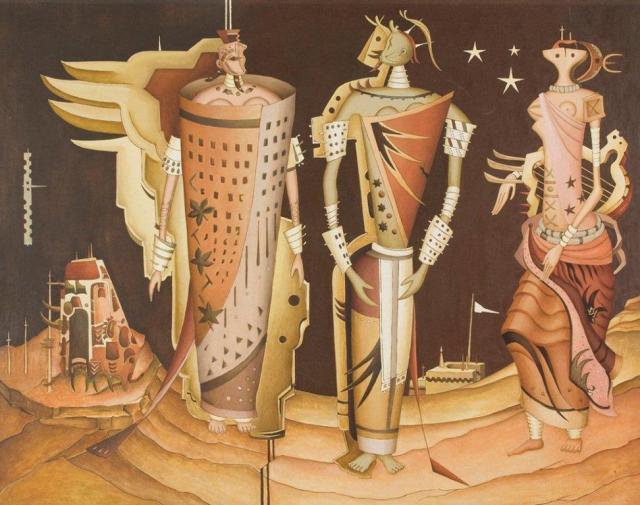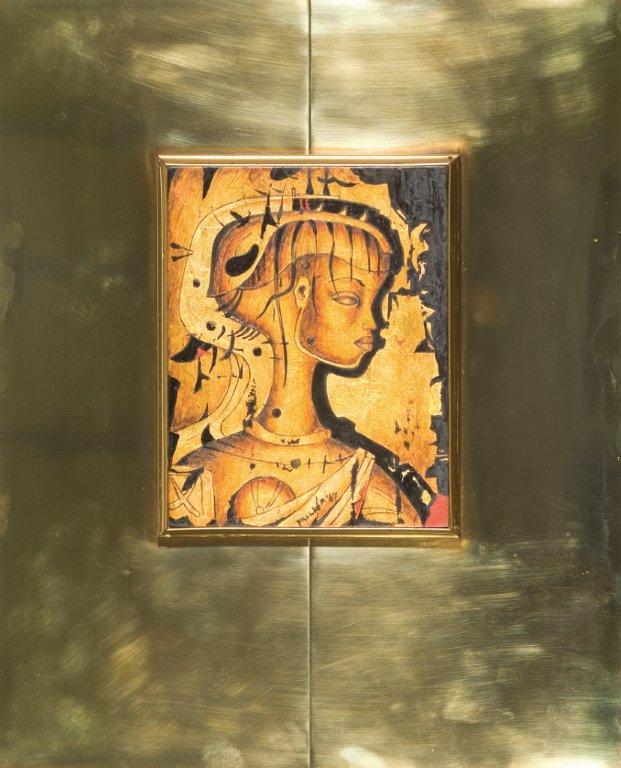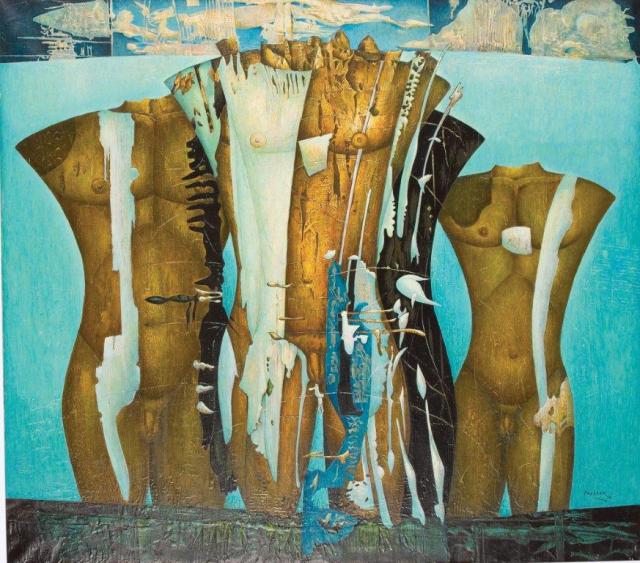
Alexis Preller. Hieratic Women 1955-57. Oil on canvas 20.8 x 151.3 cm University of the Witwatersrand Art Gallery (Source Standard Bank Gallery)
‘Whatever I am after is contained in an African shape …’ Alexis Preller[1]
Reflecting on Alexis Preller’s extraordinarily visual life with Karel Nel…
More often than not artworks at exhibition openings serve as a backdrop for a social event. The opening of Alexis Preller: Africa, the Sun and Shadows (14 October – 5 December 2009) at the Standard Bank Gallery in downtown Johannesburg was no exception. A larger than usual throng of who’s who in the Johannesburg art world crowded into the bank’s dining hall for drinks, snacks, speeches and to ‘work the room’ before being herded into the exhibition space to get a glimpse of the artwork. It was at this point that my art loving friend and I fought our way out of the gallery and decided to return at a later date to view the art properly.
A week later we joined a walkabout led by Karel Nel, artist and professor in fine art at the University of the Witwatersrand (WITS), who curated the exhibition in collaboration with well known art historian, Esmé Berman. Together they also produced the sumptuous two volume monograph of the artist, Berman taking on the bulk of the text with contributions from Nel, while the latter also designed the layout for the publication. It took years of research and preparation to present so comprehensively and splendidly the work, life and influences of Preller (1911 – 1975), one of South Africa’s pre-eminent twentieth century artists. The exhibition was curated to create a visual narrative of the artist’s life and effectively illustrates Preller’s progression as an artist throughout his prodigious career.

Alexis Preller, Gold Primavera, 1967. Oil and gold leaf on wood. 23 x 18 cm. Private Collection (Source Standard Bank Gallery)
The exhibition was an unexpected revelation. I had come across Preller’s work over the years, but was not familiar with the complexity and breadth of his artistic talent and output – what Nel describes as his ‘incandescent body of work’. One can only concur with Nel that the artist’s work has been overshadowed by many of his more famous contemporaries, artists such as Irma Stern, Walter Battiss and JH Pierneef who steal the headlines with record breaking prices for their art at auction in recent years.

Alexis Preller, Woman with a Lyre, 1956. Oil on canvas. 152 x 122 cm. Private Collection (Source Standard Bank Gallery)
As Nel points out, there has been a paucity of information on Alexis Preller since his last major exhibition, The Retrospective Exhibition at the Pretoria Art Museum, held in 1972, three years before the artist’s death. At the time of the exhibition, a ten page catalogue was published, made up of an essay written by Berman and illustrated with 20 black and white reproductions of the artist’s work. It was to be the last publication on the artist until now.
Approaching the central circular gallery space at the more recent exhibition, I was struck by the commanding, stylised and heroic paintings in exquisitely nuanced colours that graced the walls. It was as though I had entered into an undiscovered new kingdom inhabited by mythical figures, distinctive, majestic yet firmly grounded in their world. Preller created a universe at once exotic, exhilarating and strange, one born out of his own unique artistic language and imagery that has given visual form to his world.

Alexis Preller, Marathon, 1970. Oil and gesso on canvas. 122 x 137 cm. Gordon Schachat Collection (Source Standard Bank Gallery)
Nel explained how Preller created this universe to make sense of himself as an artist, as an Afrikaner living in Africa, as a white South African and as a homosexual man in the mid twentieth century. It would seem an insurmountable undertaking, but once Preller decided to become an artist, he painted every day (in the early years his friends sometimes brought him food to keep him going). Preller’s work is challenging for the reason that his multiple influences and references ‘melded the real world with an internal, psychological one’, says Nel. Because Preller’s work is not that easy to ‘read’ and that he is demanding of his audience may well account for the fact that Preller’s was overlooked in the past, Nel observes.
Preller, from the earliest days of his career, had a remarkable grasp of artistic styles and the language of art. Preller also studied art in London in the 1930s absorbing western art. Like many great artists who have over the centuries learnt from other artists, Preller engaged intensely with the work of other artists. But he was able to fuse these references with local imagery thereby creating a harmonious and unique cross-cultural world. He references Cezanne, he pays homage to Vincent van Gogh and he alludes to Gauguin and Picasso, and South African artists such as Irma Stern and Maggie Laubser, but skilfully makes these recognisable references his own. He incorporated into his work what he referred to as his ‘domestic gods’, for example, a favourite vase, candles or eggs.
Preller was also very interested in Renaissance art, more specifically the frescoes of Piero della Francesca and Duccio. What is of particular interest is that Preller began to quote from the artistic canon, different styles and symbols, before there was easy access to such references and prior to international art books being readily available in South Africa.
Nel explains how Preller had a very particular vision, a very potent one, because it locates itself within but opens out into world culture. Even though Preller drew inspiration from afar his work is infused with his own life experience. From his early years as a painter he makes powerful references to his own life and to the country of his birth, more specifically the local Ndebele people who lived in the vicinity of Pretoria where he spent most of his life. Preller also travelled to other parts of Africa, visiting Swaziland, the Seychelles, Zanzibar, Egypt and the Congo, and took inspiration from the African collection in the Trocadero Museum in Paris.
Preller has been labelled a Surrealist (which he rejected) or an Expressionist (by Walter Battiss). But a more accurate description, Nel says, would be that Preller’s artistic language is based on Modernism, with a powerful sense of regionalism. He was an avant-garde artist who was able to synthesise the language of modernism within an African frame of reference. Unlike the artist, Nel does not dismiss Preller’s association with certain elements of the Surrealists and Nel believes that a greater understanding of Preller’s work can be gained when viewing his work within the context of the psychological charge and minimalist approach of the Surrealists.
With this exhibition Nel and Berman have certainly succeeded in bringing to the forefront the reach and scope of Preller’s work, and have elevated the artist to his rightful place in the South African art lexicon. Criticism that the artist’s use of colour and stylised images verged on being kitsch is laid to rest – even though some of his experimental work over the years may have been less successful than others.
The extensive two volume monograph of the artist, Alexis Preller: Africa, the Sun and Shadows and Alexis Preller: Collected Images[2], is generously illustrated with a large collection of Preller’s work and biographical photographs, many taken by acclaimed photographers and friends or the artist. Particularly appealing is the inclusion of the art, photography and objects that influenced Preller, the many references that found their way into his own visual vocabulary. The two part monograph provides a visually vibrant, well researched, detailed and informative account of the artist’s life and work, written with (deservedly) great respect and insight into the art of the man, an artist in South African in the twentieth century.
Standard Bank Gallery walkabout with Karel Nel on 23 October 2009
[1] Berman E/Nel K, 2009, pg 302, Africa, the Sun and Shadows, Shelf Publishing, Johannesburg
[2] Berman, E. & Nel, K. (2009) Alexis Preller: Africa, the Sun and Shadows and Alexis Preller: Collected Images. Saxonwold, Johannesburg. Shelf Publishing.




Wonderful site! Great clear images and interesting, well-written comments. I look forward to more “musings”!
I find the black background and grey text difficult to read, so I will have to print out the articles.
A welcome and professional addition to sources of information on SA art.
LikeLike
Great site, lots to enjoy and learn and revisit. Am enjoying the opportunity to mull over past and present exhibitions as seen through your eyes. Agree the grey tex is a challenge later in the day.
A great new view.
LikeLike
Thank you for the very positive response to Marvellous Art Musings. Remember to register for updates. Only email (protected) is required.
I have taken note of your comment that the light grey text on a dark background is ‘challenging’ to read. It has been changed. Let me know what you think. MAMs
LikeLike
Point taken. You will notice that I have needed your advice and hopefully you will find the dark print on light background much easier to read. MAMs
LikeLike
Pingback: Musing on some of my favourite art events in 2009 | Marvellous Art Musings
I LOVE PRELLER – WHAT A PITY THE VALUE OF HIS ART , IN RANDS , IS BEEN SEEN AFTER HIS LIFE
LikeLike
Dear Ashraf,
Alexis Preller is indeed an extraordinary artist and was much under-valued during his lifetime. It is good to see that his work is now receiving the critical appreciation it deserves, also fetching good prices, but indeed sad that this has only happened after his death – such a frequent occurence.
Best regards,
MAMs
LikeLike
Pingback: Visual Theory – Gerard Sekoto 1913 – 1933 « Matric Design and Visual Arts
For me Alexis Preller leaves that phsychological message in most of his art, that is the magic of his work, combined with his uplifting colours you will never tire of looking at his work..
Dawn Cairs Hout Bay
LikeLike
I loved reading this article. Thank you so much. I have a friend who has a Preller – Gold leaf and Oils. Named ” Phoenix”. When I visit her, I find myself gazing for hours and constantly see more and more…..
Melanie
LikeLike
Pingback: aRtbio | Gerard Sekoto, South African Artist and the | ART | library deco